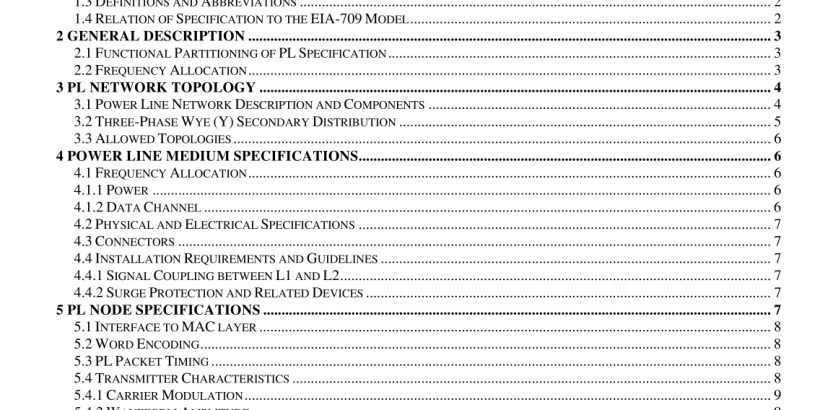ANSI CTA 709.2-A-2000 pdf download.Control Network Power Line (PL) Channel Specification
1.3 Definitions and Abbreviations
The following definitions and abbreviations deal specifically with the power line medium and physical layer shown in figure 1. A more complete set of definitions will be found in EIA-709.1-A. PL Node – A user node attached to the power line medium at a tap that meets the requirements of this specification. Home Network – A single power line bus contained within one home. That part of a power line network defined to be from the power line service entrance (including a breaker panel) to all local home loads. Line Cord – A cable not part of the power line network that allows an EIA-709.2 node located away from the power line network to be connected to the network. Power Line Network – A communication network based on power distribution lines (“power lines”), from the final distribution transformer to and including all homes served by that transformer, including all wiring in those homes. Non-Network-Powered Node – An EIA-709.2 compatible node that attaches to the power line network but does not draw any power from the network.
2 General Description
This section provides a general description of the power line physical layer and medium requirements. To simplify the specification, the physical and medium layers are logically divided into several physical parts described in the following subsections. This section also overviews the frequency allocation of the medium.
2.1 Functional Partitioning of PL Specification
This specification divides the complete EIA-709.2 power line environment into three basic parts: the network topol- ogy, the medium, and the node physical access specification. The network topology specification deals with the anticipated configurations of power line wiring likely to be found in most installations. The medium specification concerns the capabilities and properties of the physical medium. This encompasses such items as its bandwidth, frequency allocation, electrical and physical specifications, connectors, etc. The node physical access specification deals with the physical properties of that part of the node that makes contact with the medium. Also described is the interface between the physical layer and the symbol-encoding sub-layer.
2.2 Frequency Allocation
The EIA-709.2 specification allows for a control channel frequency allocation. A control channel frequency space is reserved on each medium for the exchange of control information and user data concerning the state of the EIA-709 system and its applications. The control channel does not have to allocate its frequency space on the medium since this space is permanently reserved as part of this specification.
The word “home network” describes a single dwelling (see definitions). This network contains many resistive and reactive loads randomly connected and disconnected. The power line network is typically isolated by a distribution transformer appearing as an high impedance to signaling frequencies used by EIA-709.2 nodes. Figure 2 is intentionally drawn to physically represent a typical North American power line network to make clear several unique topological conditions found in these networks. In particular, any power line node in any home may communicate (and interfere) with any power line node in any other home on the network. Likewise, sources of net- work noise and load are not isolated to a home on the network. The number of homes on a power line network may vary from one upward. The upper limit is usually eight, but larger numbers are not uncommon. This same inter- home coupling phenomenon applies to countries outside of the U.S. where single phase 230 V AC is typical. Figure 3 depicts a more general representation of the power line network. The figure shows that electrically, the home is only a logical concept, and all power line nodes appear on either a pair of 120 V AC lines (L1-N, L2-N), or 240 V AC lines (L1-L2) originating at a distribution transformer.ANSI CTA 709.2-A-2000 pdf download
